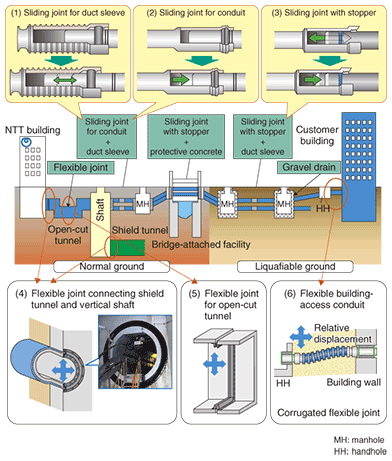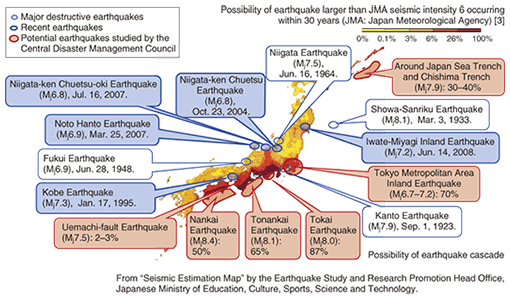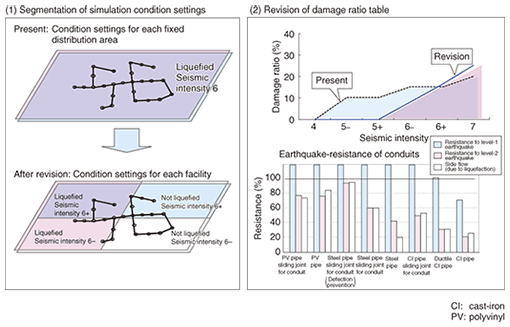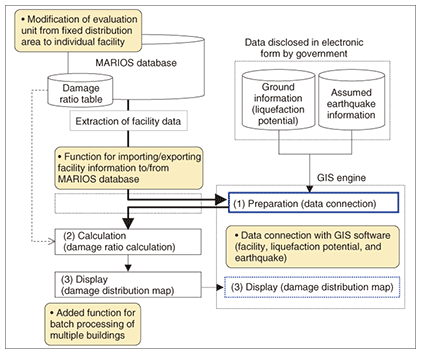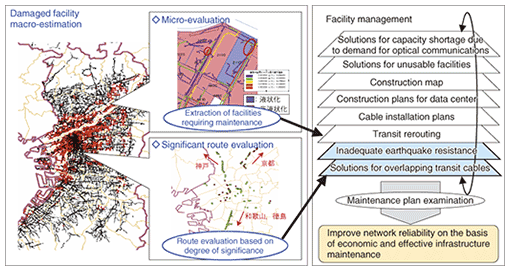 |
|||||||||
|
|
|||||||||
|
Letters Vol. 8, No. 1, pp. 33–39, Jan. 2010. https://doi.org/10.53829/ntr201001le1 Development of Earthquake-resistance Evaluation Technologies for Telecommunication FacilitiesAbstractThis article introduces some recent upgrades to technologies for evaluating the capability of telecommunication facilities to remain functional after an earthquake that simulate in advance the damage that might occur to underground telecommunication facilities when a large earthquake occurs. The upgrades include 1) revisions to the damage ratio table based on an analysis of actual damage to facilities caused by past earthquakes, 2) the application of geographical information system technologies, and 3) improvements in simulation accuracy and effectiveness that drastically shorten the evaluation time by utilizing information available from central and local governments.
1. IntroductionThe NTT Group has been working on various countermeasures against large-scale disasters by upgrading the reliability of telecommunication networks and ensuring the availability of critical telecommunication links and quick recovery of damaged services [1]. We have continuously developed earthquake-proofing techniques and have improved facilities on the basis of actual damage to facilities by past earthquakes, which have caused both human injury and serious functional decline to telecommunication services (Fig. 1). However, those technologies have been applied only to newly constructed facilities. There are many old facilities constructed to outdated specifications that have inadequate earthquake resistance.
According to the Central Disaster Management Council of the Cabinet Office, the probability of a major earthquake occurring within thirty years is estimated to be 70% for an inland earthquake in the Tokyo metropolitan region and more than 80% for a Tokai Earthquake [2]. There is also a risk of a cascade of several earthquakes in the ocean trench, which could cause heavy damage to a wide area (Fig. 2). Public awareness of the dangers of earthquakes has been growing. On the other hand, the huge quantity of telecommunication facilities constructed during the 1960s and 70s has aged, and these facilities will soon require maintenance. Under these circumstances, it is essential to improve the reliability of the network platform in order to promote the spread of services on the Next Generation Network (NGN), which is being touted by NTT as a highly reliable network. Effective infrastructure construction with limited business resources to ensure the continued availability of facilities in the event of the inevitable occurrence of earthquakes is becoming one of the most important business challenges.
We have developed technologies for evaluating earthquake-resistance in order to comprehend the damage that earthquakes cause to facilities and to maintain telecommunication facilities effectively and systematically. 2. Existing technologies2.1 OutlineThe damage that facilities may suffer from a possible future earthquake can be estimated statistically by analyzing facility damage from past earthquakes and adjusting it according to seismic scale, ground stability, and facility type. This method has been introduced and is currently used as one of the application programs of the planning system for NTT’s outside facilities (called MARIOS). This application program is used for systematic facility construction. The earthquake-resistance evaluation technologies are outlined in Fig. 3 and described below.
First, on the basis of ground information (published by the Geographical Survey Institute) and earthquake information (JMA magnitude, depth, and epicenter coordinates from the Japan Meteorological Agency), for each fixed distribution section (unit area of telecommunication cable distribution), the seismic intensity [3] and likelihood of liquefaction are estimated. The possibility of damage to each facility (hereinafter, damage ratio) is estimated by crosschecking the earthquake information and facility information (by facility type, construction year, etc.). The estimated damage ratio for infrastructure (conduits, manholes, bridges, etc.) is established using a crosscheck table (hereinafter, damage ratio table), which is edited from the relationship between facility damage data and seismic intensity. Underground cables are also evaluated using the damage ratio table. Experimental studies have determined how cables are damaged (cable damage degree, transmission loss, fiber strain, etc.) after a conduit suffers damage from ground deformation and how external forces act on cables. The damage ratio table for cables was created considering the mechanism and quantified seismic intensity, liquefaction, and ground deformation. It leads to a highly effective facility construction plan because weak points can be identified at the service level. 2.2 ProblemsThe abovementioned technologies were introduced in 2007 and have been used for facility management. However, some issues, which require improvements, have become apparent. 1) Since the damage ratio table was established on the basis of only the 1995 Kobe Earthquake, its accuracy is not very high. 2) Since earthquake and ground information corresponds to a fixed distribution section as a unit, it is difficult to set detailed conditions within a particular area, which degrades the evaluation. 3) It takes a long time to set up the relationships for the huge quantity of facility, ground, and earthquake information. 4) The handling unit is limited to a single operation office area at a time, which is inconvenient for evaluating multiple areas. We have improved the accuracy and effectiveness of the simulation by utilizing geographical information system (GIS) technologies, which enable the integration of various kinds of coordinate-based information. These improvements also promote environmental aspects, which have recently become available to the public through the disclosure by central government and local governments of earthquake information and liquefaction maps. 3. Recent updates3.1 Improved evaluation accuracyWe have improved the evaluation accuracy by reexamining the damage ratio table on the basis of actual facility damage caused by the 1995 Kobe Earthquake and incorporating the results of damage analyses for several recent large earthquakes (2005 Chuetsu Earthquake, 2007 Noto Hanto Earthquake, and 2007 Chuetsu-oki Earthquake). Modifying the earthquake estimation target, such as seismic intensity and liquefaction potential, from a fixed distribution area to an individual facility has also contributed to improvements in evaluation accuracy (Fig. 4).
When the damage ratio tables were revised, recent knowledge and findings were combined with the results of a review of past earthquake damage. As a result, the evaluation reflects the reality that there was no damage to conduits, other than some weakening of pipes, when the seismic intensity was below five minus (5-). The main features are: 1) segmentation of seismic intensity scale in both normal and liquefiable ground and 2) reflection of the earthquake resistance of each conduit type. 3.2 Streamlined simulationEvaluations performed with the existing application take a long time and require a huge number of man-hours to enter earthquake and ground information. Since the central and local governments have recently begun to make available the various types of data needed for simulation, we streamlined the simulation by combining that data with commercially available GIS software (Fig. 5). Wide area simulation is achieved by a new function for evaluating several operation areas together. These improvements have greatly reduced the evaluation time from 7 to 0.5 hours per operation area.
The key improvements are: – addition of a function for importing and exporting facility information to and from the MARIOS database, – modification of the evaluation unit from a fixed distribution area to an individual facility, – addition of a function for treating several operation areas together, and – combination of government data and commercially available GIS software. 4. Concluding remarksThere are various other triggers for infrastructure upgrading besides earthquake-proofing such as aging, capacity shortage, the need to resolve transit route overlaps, cost reduction through cooperative construction with other lifeline enterprises, and relocation to avoid hindrances. To keep maintenance costs down, it is necessary to carry out measures effectively by combining them. The evaluation technologies described in this article should make it possible to predict earthquake vulnerabilities beforehand. Moreover, combining the evaluation results with other countermeasures such as redundancy construction for key routes should lead to improved network reliability (Fig. 6).
References
|
|||||||||








